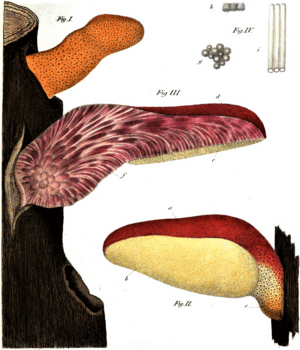Beefsteak polypore facts for kids
|
||||||||||||||||||||||||||||||||||||||||||||||||||||
The Fistulina hepatica is a special type of bracket fungus. People also call it beefsteak fungus, beefsteak polypore, poor man’s steak, ox tongue, or tongue mushroom. It gets these names because it looks a lot like a piece of raw meat!
You can often find this fungus in Britain. But it also grows in North America, Australia, North Africa, Southern Africa, and other parts of Europe. Long ago, people even used it as a meat substitute. You might still see it in some markets in France today. It has a slightly sour taste. If you want to eat it, it's best to pick younger ones. Older ones can be tough and need to cook for a long time.
About the Beefsteak Fungus
The top part of the fungus, called the cap, is usually 7 to 30 centimeters wide. It can be 2 to 6 centimeters thick. Its shape often looks like a big tongue. The surface feels rough and is a reddish-brown color.
Underneath, the fungus has tiny holes called pores. These pores release pink spores. When the beefsteak fungus is young, it is a pretty pinkish-red. As it gets older, its color becomes darker. If you cut it, a dull red juice will come out. This juice can stain things, and the inside of the fungus looks even more like meat.
Taste and Eating
The beefsteak fungus has a sour taste. Many people enjoy eating it. Some even consider it a "choice" mushroom. However, if you find an older one, it's a good idea to soak it in water overnight. This is because the juice from older fungi can sometimes upset your stomach.
How it Grows
The underside of the fungus is full of tubules. These are like small tubes where the spores are released. The name Fistulina means "small tube" in Latin. The word hepatica means "liver-like," which describes how the fungus feels.
This fungus is quite common. You can often find it growing on oak trees and sweet chestnut trees. It grows on both living and dead wood. The best time to find it is from August until the end of autumn.
When the beefsteak fungus grows on oak trees, it can make the wood turn a reddish-brown color. This special wood is sometimes used for building. In Australia, it can grow on Eucalyptus trees, especially where the tree has been wounded. The fungus causes a type of brown rot in the trees it infects.
See also
 In Spanish: Hongo bistec para niños
In Spanish: Hongo bistec para niños



